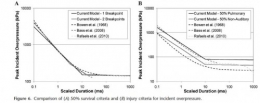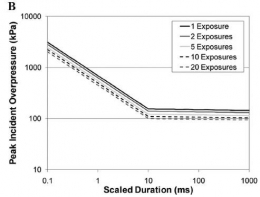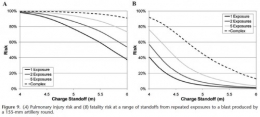Exposition répétées: Plus graves ! ou ?
18/02/2012
Primary blast survival and injury risk assessment for repeated blast exposures
Panzer MB et all. J Trauma. 2012;72: 454–466.
Les conflits afghnas et irakiens ont vu les personnels des armées occidentales confrontées à de nouvelles modalités d'exposition à des ondes de surpression. Leur caractèes répété est responsable de lésions plus graves. Cet article actualise un certain nombre de données.
Ces quelques diagrammes expriment de manière très claire la relation entre le pic de pressions, sa durée et la répétition sur la survie et les lésions observées.
-------------------------------------------------------
BACKGROUND:
The widespread use of explosives by modern insurgents and terrorists has increased the potential frequency of blast exposure in soldiers and civilians. This growing threat highlights the importance of understanding and evaluating blast injury risk and the increase of injury risk from exposure to repeated blast effects.
METHODS:
Data from more than 3,250 large animal experiments were collected from studies focusing on the effects of blast exposure. The current study uses 2,349 experiments from the data collection for analysis of the primary blast injury and survival risk for both long- and short-duration blasts, including the effects from repeated exposures. A piecewise linear logistic regression was performed on the data to develop survival and injury risk assessment curves.
RESULTS:
New injury risk assessment curves uniting long- and short-duration blasts were developed for incident and reflected pressure measures and were used to evaluate the risk of injury based on blast overpressure, positive-phase duration, and the number of repeated exposures. The risk assessments were derived for three levels of injury severity: nonauditory, pulmonary, and fatality. The analysis showed a marked initial decrease in injury tolerance with each subsequent blast exposure. This effect decreases with increasing number of blast exposures.
CONCLUSIONS:
The new injury risk functions showed good agreement with the existing experimental data and provided a simplified model for primary blast injury risk. This model can be used to predict blast injury or fatality risk for single exposure and repeated exposure cases and has application in modern combat scenarios or in setting occupational health limits.
-------------------------------------------------------





Les commentaires sont fermés.